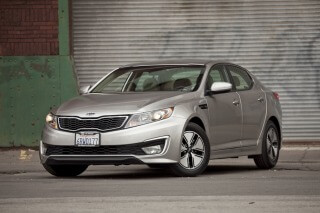
Kia’s Optima sedan is such a perfect blend of styling, value and practicality that it won Cars.com’s highest honor as our Best Car of 2011. The hybrid version attempts to take on the likes of Toyota’s Camry Hybrid, Ford’s Fusion Hybrid — a past winner of our award — and its Hyundai counterpart, the Sonata Hybrid. All while the Toyota Prius overshadows them all with a 50 mpg combined rating and comparable interior room.
What’s a hybrid sedan to do?
The 2012 Kia Optima Hybrid doesn’t deliver top mileage, but if you’re shopping for a hybrid sedan, it’s as competent a player as you’ll find on the market.
Full reviews of the gasoline only Optima and Optima Turbo can be found here.
Hybrid Powertrain
The Optima Hybrid uses both electric and gas power plants to propel the car, either in tandem or independently, while achieving an EPA-estimated 35/40 mpg city/highway, 37 mpg combined.
The electric motor can power the car on its own — even up to highway speeds when driving conditions and battery level allow. In short, when you hammer on the accelerator the two systems work together, but when cruising at higher speeds the electric (EV) mode kicks in for as long as the battery’s charge allows.
All this interaction works seamlessly and almost imperceptibly, unless you’re looking at one of the information screens that detail the process. A small color display between the gauges is standard, and the optional navigation system provides more detailed information on a dashboard touch-screen.
Steering and ride comfort were similar to the standard Optima four-cylinder I tested previously, but I thought the hybrid’s overall experience was quieter.
Braking was nice and linear, a trait new hybrids have developed despite using regenerative setups to recapture energy for the battery.
During my regular congested commute, I was seeing mileage in the high 30s, which is perfectly acceptable for what the car promises. Because of this system’s design and its ability to cruise at high speeds in EV mode, drivers who spend more time on open roads at highway speeds will benefit most in terms of fuel economy.
Hybrids from Ford and Toyota emphasize city efficiency.
We recently calculated that it would take six years for buyers to recoup their higher investment in the Optima Hybrid through lower fuel costs versus a similarly equipped four-cylinder Optima. While getting those terrific mileage figures will make you feel better on your commute, the higher payments at the end of each month might be a downer.
The hybrid battery cuts into trunk space, as it does in nearly every hybrid sedan. In the Optima, cargo space goes from 15.4 cubic feet in the regular version to a very small 9.9 cubic feet in the hybrid. The Toyota Camry goes from an identical 15.4 cubic feet in the gas-only model to a very respectable 13.1 cubic feet in the hybrid version. Plus, the Optima Hybrid’s rear seats don’t fold flat.
Equipment
My tester was a base model with cloth seats, no navigation and a sticker price of $27,500, which is considerably higher than the base gasoline car’s $19,500. However, there are quite a few standard features in the hybrid that don’t come standard in that model, including a power driver’s seat, cruise control, dual climate control and push-button ignition.
Navigation, leather and other options can be had, but only as part of a single option package called the Hybrid Premium Technology Package. For $5,000, it adds a panoramic moonroof, a navigation system, an eight-speaker stereo, a power passenger seat, leather seats, heated and cooled front seats, 17-inch alloy wheels and high-intensity-discharge headlights.
Safety
The Optima Hybrid earned a five-star overall crash test score from the National Highway Traffic Safety Administration. It also earned a Top Safety Pick designation from the Insurance Institute for Highway Safety, that agency’s highest honor. Very few cars on the market currently hold both designations.
The Optima Hybrid comes with a standard array of airbags, including side curtain airbags for the front and rear seats and seat-mounted side airbags for front occupants. You can read about more safety features here.
Optima Hybrid in the Market
The concept of a hybrid sedan still doesn’t resonate with me because, with moderate gas prices, it takes a long time to recoup the added cost versus a non-hybrid sedan. However, the Optima Hybrid delivers everything it promises and still retains the handsome looks that won me over when I first saw the non-hybrid version.



























